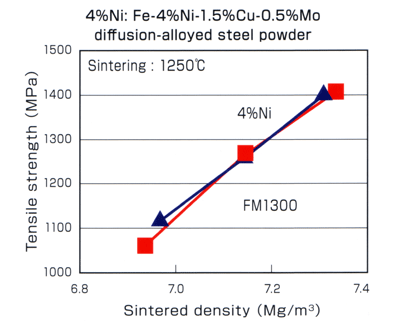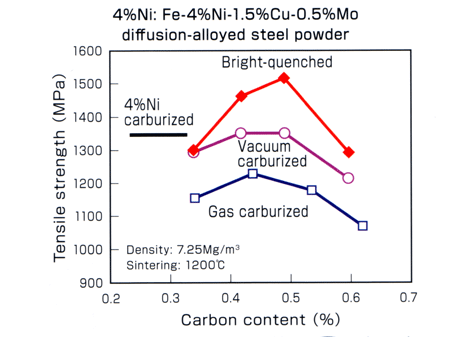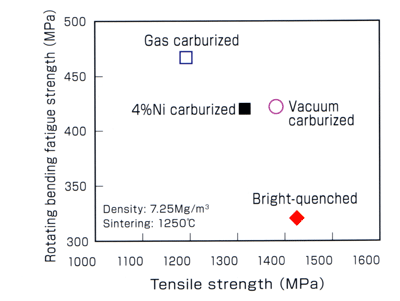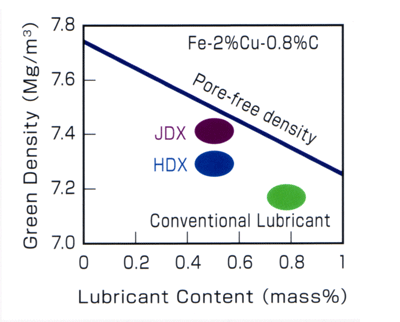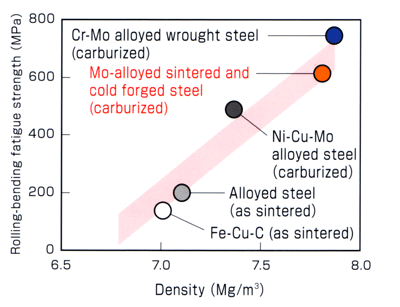JFE Steel broadens iron powder range for high performance Powder Metallurgy parts
JFE Steel has in recent years been broadening its range of steel powders to meet the demands for high density, high performance, low cost Powder Metallurgy (PM) components having high fatigue strength, as well as powders for PM parts having enhanced green density, and machinability.
Some of these developments were discussed with Powder Metallurgy Review during the recent PM2012 Powder Metallurgy World Congress held in Yokohama, Japan.
New Ni-free PM steel powder grades
In the past, diffusion-bonded Ni steel powder was widely used in PM components to achieve tensile strengths up to 1000 MPa. However, because of the sharp rise in the cost of Ni and volatility of supply, JFE Steel, along with most of the other major powder producers around the world, developed lower cost Ni-free steel powders. In the case of JFE, these Ni-free steel powders were first introduced in 2009 with the trade name JIP® FM Series.
The new FM Series are pre-mixed powders based on a low Mo content (0.45%) prealloyed powder mixed with Cu, graphite and lubricant, which can be compacted to high density and sintered in a mesh belt furnace to achieve as-sintered tensile strength of 600 MPa; in the heat treated carburised condition tensile strength reaches up to 1000 MPa, the equivalent of conventional, higher cost diffusion-bonded PM 4% Ni steels. An additional benefit of the FM Series is its excellent machinability.
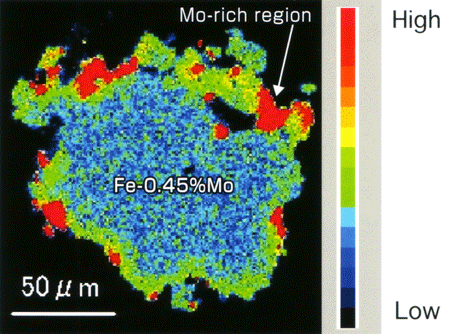
Fig. 1 Diffusion bonding of Mo to a 0.45%Mo prealloyed steel powder produces a Mo-rich region for enhanced sinterability
At PM2012 in Yokohama, JFE Steel introduced the latest in its JIP® FM Series of high strength PM steels, with the development of FM1300 and FM 1500 grades. FM1300 is a hybrid-alloyed steel powder, designated JIP AH4515, based on 0.45% Mo to which 0.15% Mo is diffusion bonded (Fig. 1).
This is said to lead to enhanced sintering and strengthening of the sintering necks due to the Mo-rich region (α-Fe phase). JFE reports that FM1300 achieves the equivalent tensile strength of conventional PM 4%Ni sintered material but at lower cost when sintered at 1250°C to >7.3 g/cm3 density (Fig. 2).Fatigue strength is also higher for the FM1300 material as is shown in Fig. 3.
The second new development aimed at reduced cost, high performance PM steels is JIP FM1500. This powder has been designated as JIP® 5CRA and is based on a lean prealloyed steel with the composition Fe-0.5%Cr-0.2%Mn-0.2%Mo. When sintered to a density of 7.25 g/cm3 at 1200°C the bright-quenched material has a tensile strength in excess of 1500 MPa (Fig. 4). The rotating bending fatigue strength of sintered and gas carburised JIP® 5CRA steel shown in Fig. 5 is higher than that of the conventional 4%Ni PM steel.
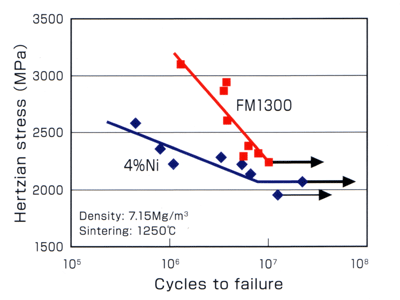
Fig. 3 Comparison of rotating bending fatigue strength (top) and contact fatigue strength (botom) of sintered FM1300 grade and 4%Ni PM steel
Improved lubrication system for high green density
In 2009 JFE began marketing its JIP® Clean Mix HDX lubricant to allow the compaction of parts to high green densities at room temperature whilst maintaining superior powder flow characteristics compared to conventional pressing lubricants such as wax or zinc stearate.
Now the company has added its Zn-free JDX-CMX lubricant system to its Clean Mix range which allows the reduction in the amount of pressing lubricant required to reach the desired green density. The company states that even a small amount of the new lubricant provides the intended density under lower compacting pressure (see Fig. 6), which allows a lower tonnage powder press to be used to produce larger, high density compacts.
Improved machinability PM steels
There is an increasing demand for more complex shaped PM structural parts having higher dimensional accuracy, and many PM parts are today machined after sintering to meet these demands. This has required effort on the part of the powder manufacturers to develop free machining additions for PM steels such as MnS to improve machinability; however these can cause problems such as the contamination of the sintering furnace.
In order to solve this JFE Steel developed its JIP® Clean Mix JFM Series which has the 0.2% addition of a silica containing composite oxide powder to promote shear deformation of chips during machining. Additionally, the composite oxide powder forms a protective film on the tool during machining thereby reducing tool wear.
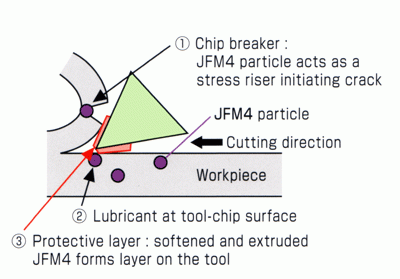
Fig. 7 Function of JFM4 particles dispersed in the sintered workpiece as chip breaker and lubricant at the tool-chip surface
The mechanism of machinability enhancement using JFM4 is shown in Fig. 7. Fig. 8 shows that flank wear is significantly reduced after 550m turning of the JFM4 sintered material compared with 0.5% addition of MnS and PM Fe-2%Cu-0.8%C with no machining additive. There is said to be little difference in the mechanical properties and dimensional change in the newly developed material compared with additive-free PM grades. Toshio Maetani and his colleagues from JFE Steel Corp. Research Laboratories presented a paper on this development at PM2012.
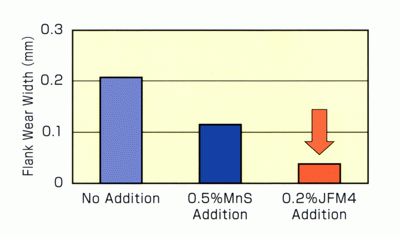
Fig. 8 Reduced flank wear with the 0.2% JFM4 machining addition after 550m turning. (Workpiece: Sintered Fe-2Cu-0.8C; cutting speed: 200m/min, cutting depth: 0.5mm, feed rate: 0.1mm/rev.)
Cold Forging to produce fully dense PM parts
JFE also told Powder Metallurgy Review that it had recently developed a new process to produce full density, high performance PM steel parts having complex geometries by combining sintering and cold forging. The process involves compacting and pre-sintering a low alloy Mo steel powder to produce a preform which has sufficient transformability to withstand cold forging (or backward extrusion) with a reduction in area of 85% possible of the pre-sintered material.
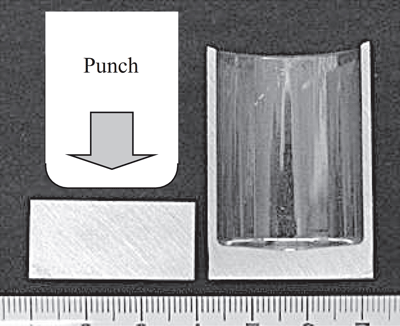
Fig. 9 Sintered preform (left) and crack-free backward cold extruded PM material (right). (From: ‘JIP® Iron powder Products and Technology Trends in Powder Metallurgy’ published in JFE Technical Report, No.16, 2011
Fig. 9 shows the sintered preform (left) with the crack-free cold forged material (right). The fully dense cold forged material is re-sintered and heat treated (carburised) to achieve a rotating bending fatigue strength of 600 MPa, and hardness of 60 HRC, which is comparable to the hardness of Cr-Mo alloyed wrought steel. JFE states that automotive transmission gears are just one area of potential applications.
News | Articles | Market reviews | Search directory | Subscribe to e-newsletter



